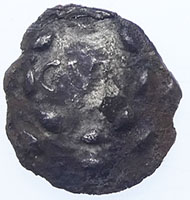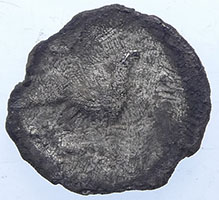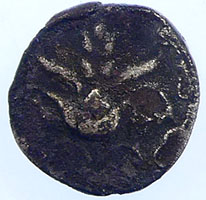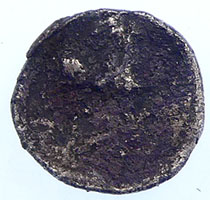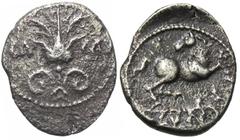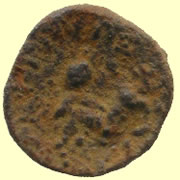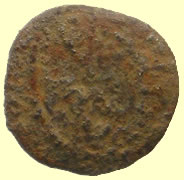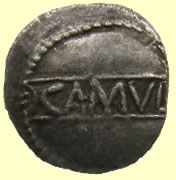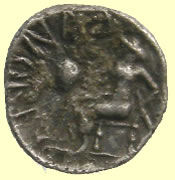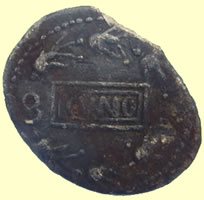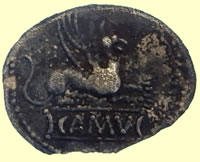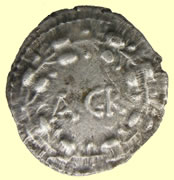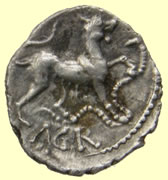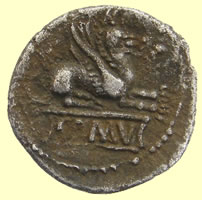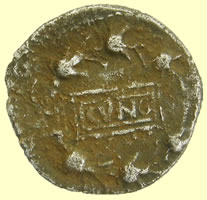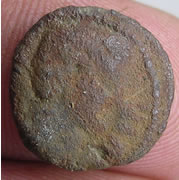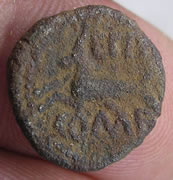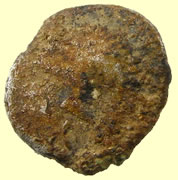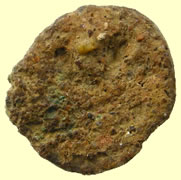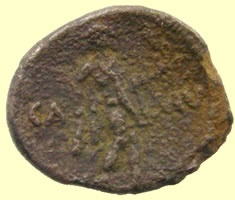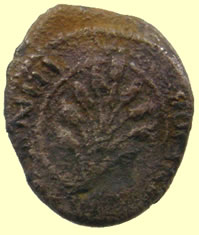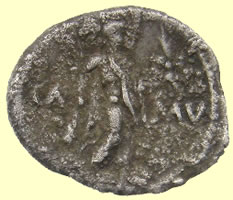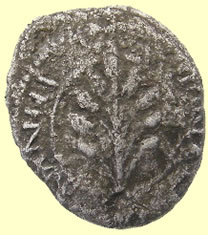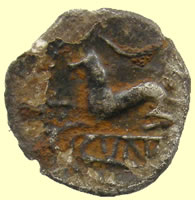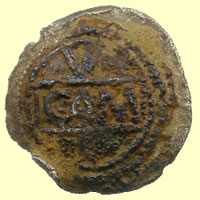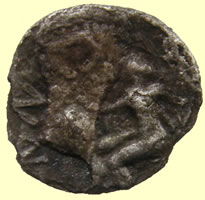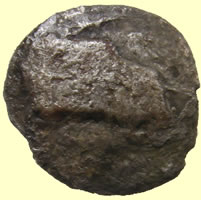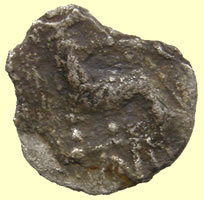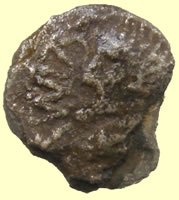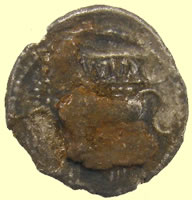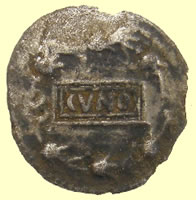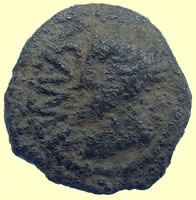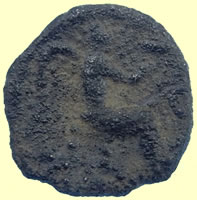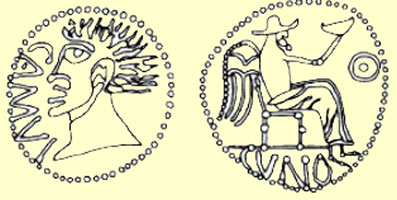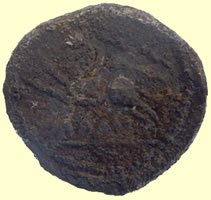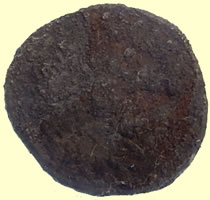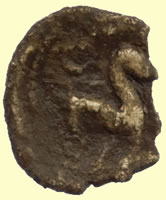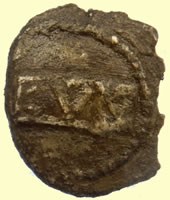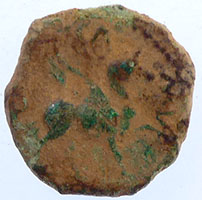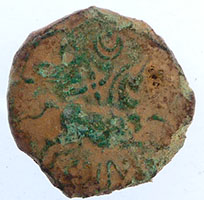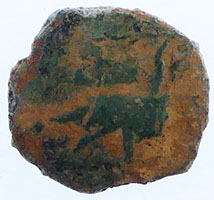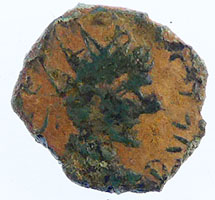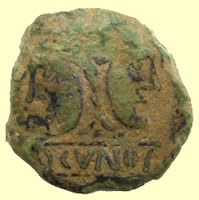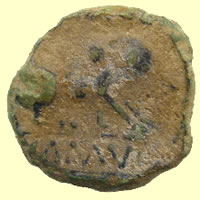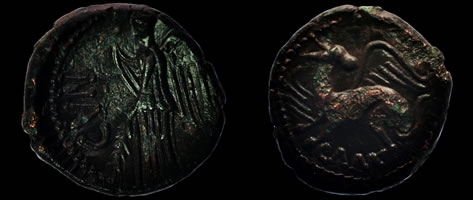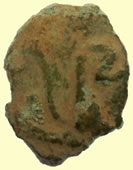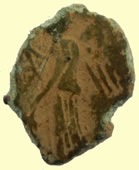

Metal detecting holidays in England with the World's most successful metal detecting club.
Twinned with Midwest Historical Research Society USA
| Celtic silver and bronze coins | |
10-40 AD Cunobelin Celtic silver unit - 0.69g - 13.9mm - sent to CCI for recording Bitch and snake CVN within wreath./Bitch r.,clutching snake in paws,CVN in ex. Classed as Unique in Ref ABC Chris Rudd 32.78 Previous CCI 03.0568
10 to 40 AD Cunobelin Celtic silver unit Flower type - Classed as Extremely rare - Chris Rudd 54.78, VA 2049, ABC 2885
|
|
As dug,almost 'cooked' and finally cooked 1stC Celtic silver unit - straight into the cooker to remove the horn crust Cunobelin 20 AD Celtic silver coin The Cunobelin silver is very nice, and a rare type at that. Seated figure facing left. The only standard reference for the type is no. 308 in Spink's Coins of England, it's not in Van Arsdell or the BM catalogue. You can see the amphora which the seated figure is holding quite clearly, but the CVNOBE doesn't show up too well on either. I don't have the exact figures here for rarity, but I don't think there are more than a dozen of these recorded at most. Date is perhaps somewhere in the middle of Cunobelin's reign, say perhaps c. 20-25 AD.
10-40 AD Cunobelin Celtic silver unit Sitting Griffin type - CVNO in tablet, wreath border Griffin right on tablet containing CAMV - Classed as Extremely Rare VA2051 1.25g, 14.29mm |
|
A British Iron Age Eastern uninscribed silver unit of AGR and Cunobelin, c. AD 30-40. The coin is of the type ABC (Cottam et al 2010) 3005. It features the letters AGR on the obverse and reverse and can be related to ABC 2891 = VA (Van Arsdell 1989) 2069 with the same designs but the inscriptions CAM/CVN (for Cunobelin). This coin is registered as CCI 11.1069. This is one of two coins of this type recorded on the PAS datbase, the other being ESS-A77FE5 . Examples on the Celtic Coin Index include CCI-971368 , CCI-971258 , CCI-940881 , CCI-900849 and CCI-20259
|
|
10-40 AD Northern silver of Cunobelin - AR unit Hobb 1868 Obv 'CVNO' inside double rectangle, all inside wreath pellet boarder Rev winged griffin r.,below 'CAMV' inside quad.o,pellet boarder |
|
Sego 10 BC to 10 AD Silver Celtic unit Celtic silver coin found in Kent by one of our members - left with me to record properly with the Celtic coin index and obtain export license correctly - 1.34g, 14.01mm
'Thanks very much for this. As you probably know the type has a very Kentish distribution, so if it is of Tasciovanus – the traditional attribution – it seems to have been produced specifically to be used there. The other interesting feature is of course the inscription itself, which is often now interpreted as meaning ‘victory’ or something similar, rather than a personal name. Tasciovanus winning a battle in Kent, perhaps? I’ll record it as CCI 08.9335. There are only seven on the web at http://www.finds.org.uk/CCI/images-lister.php?&VA_type=1851.01 and although the number may have gone up a little since then, it can’t be by many – perhaps a dozen at most. All the best Philip' |
|
It's a silver unit of Eppillus, VA 443-1, with a head right on the obverse and inscription IO VIR or CO VIR or FO VIR, and on the reverse a Capricorn left with EPPI above and COM F below. There's a page of them at: Celtic Coins Although Eppillus appears to have been from the Atrebates, this is one of the coins he struck which is found predominantly in Kent, reflecting his brief period of rule there probably around the turn of the first century BC/AD. The obverse inscription of this type is a bit of a puzzle: CO VIR would presumably be Commios and Verica, but it's not clear whether IO and FO refer to other words or whether they're simply mistakes by the die engraver'. CCI number to follow 1.52g,13.75mm
|
|
10- 40AD Cunobelin silver 1/4 stater - very rare find 'cooking' it to remove crust
'Many thanks for this one. As I'm sure you already know it's a Cunobelin type, quite a scarce one too. The catalogue reference is VA 1949, and there are 29 of them in the online CCI: http://www.finds.org.uk/CCI/images-lister.php?&VA_type=1949.01 The obverse is pretty much unvaried throughout the type, with a simple CVN inscription in a panel, but the reverse has at least three different options in the placing of the inscription below the animal (which is probably a hunting dog). I think I can see the top of the M of CAM, for Camulodunum, on this one, but it will be easier to see when the coin is cleaned. I would also expect it to lose a bit of weight then, since 1.41g is about 0.15g heavier than usual for the type. I would guess the date of this type is fairly early in Cunobelin's reign, perhaps c. 15 - 20 AD. I'll record this one as CCI 07.1134.' |
|
As dug to 'cooked'
50BC Celtic silver 'face horse' type 1.06g - 14.18mm I have given this coin the CCI number 10.0903.
The ID is fine - it is one of the so called 'Normal Face Horse' types, probably NFH A. East Anglian (Icenian) type of c. AD 20-50. These are the latest of the uninscribed silver struck in that area and probably overlap with the inscribed coinages. However, they are nothing to do with Boudicca (as Van Arsdell suggested!)
Thanks for the info!
Ian
|
|
Monster find 10-40AD Celtic Cunobelin tribe silver coin - in the 'cooker' to remove crust 13.98mm, 1.17g rev figure stg.r.,partially draped, holding club in r.hand & palm branch in 1.,to 1.'CA',to r 'MV',pellet border Obv .leaf c inside circle,to r.'CVNOB',to 1.'[ELI]NVS', pellet boarder Similar Hobbs 1897 |
|
1stC Celtic silver unit - straight into the 'cooker' to remove the horn crust Cunobelin 20 AD Celtic silver coin The Cunobelin silver is very nice, and a rare type at that. Seated figure facing left. The only standard reference for the type is no. 308 in Spink's Coins of England, it's not in Van Arsdell or the BM catalogue. You can see the amphora which the seated figure is holding quite clearly, but the CVNOBE doesn't show up too well on either. I don't have the exact figures here for rarity, but I don't think there are more than a dozen of these recorded at most. Date is perhaps somewhere in the middle of Cunobelin's reign, say perhaps c. 20-25 AD. |
|
Celtic silver coin with a hard lump stuck to it - this will take a lot of 'cooking' to clean |
|
As dug
10-40 AD Cunobelin Celtic silver unit - 'cooking to remove crust' Cunobelin 'Horse-Dog' silver, ABC 2852 (extremely rare) is CCI 12.0389 |
|
As dug
Good example showing how thick the crust is left to 'cook' off. Cunobelin amphora type unit, ABC 2849, not in VA or BMC. Extremely rare
As dug
Bust detail is showing through the crust - lots more 'cooking' to do yet
1stC BC Cunobelin Celtic silver coin - 'cooking' it to remove crust C4 (M215, V2045, BMC 1863-65) Obv. head 1., spiky hair floating behind head. Variety with pointed ?bearded chin has CAM in front, VL behind head; others with less pointed chin have CAMV or CAMVL in front. Pellet border. Rev. seated Victory r., holding bowl in outstretched r. hand. Pellet in ring in front. CVNO below exergual line. Pellet border. |
|
The 'cooking' process clearly shows the thickness of the horn crust on this coin 10- 40 AD Cunobelinus 'Sitting Griffin' type silver unit - Classed as extremely rare VA 2051, BMC 1868-9 Chris Rudd 30.73 Cooking to clean up and sent to CCI for recording and confirmed ID Rev CVNO in tablet, wrealth border Obv Griffin r - on tablet containing CAMV I've done a card for the Sitting Griffin unit and it's now CCI 12.0835; I've used the photo you sent but will replace it with a better one when the coin's 'cooked'!
All the best John
Very rare 10 -40 AD Cunobelinus Celtic silver unit - Leaping griffin type Laureate bust r.CVNOBEL in front IINVS behind./ Griffin springing I, CAMV on ex.line. Ref ABC 2909 Classed as excessively rare 'cooking' to remove crust
10- 40 AD Celtic silver unit Cunobelinus Spiky silver unit CAMVl in front, CAM with VL behind Seated victory r.holding bowl or wine cup in r.hand CVNO below chair BMC 1863-65 classed as Very rare http://www.celticcoins.ca/vanarsdell.php?tribe=TRI&van=2045-1
1st C BC Celtic silver unit - needs cooking to remove crust - our oldest ever silver unit at c120 BC Not a type we have found before so checking ref books. Gaul. Central Gaul, the Lingones. Kaletedes. AR Quinarius, circa 120/100-50 BC. Obv. Celticized head left. Rev. Celticized... 12.1mm, 1.89g Lingones were a Celtic tribe that originally lived in Gaul in the area of the headwaters of the Seine and Marne rivers. Some of the Lingones migrated across the Alps and settled near the mouth of the Po River in Cisalpine Gaul of northern Italy around 400 BCE. These Lingones were part of a wave of Celtic tribes that included the Boii and Senones (Polybius, Histories ii.17). The Lingones may have helped sack Rome in 390 BCE.
10-40 AD Cunoblinus Leaping Griffin type Celtic silver unit Laureate bust r CVNOBEL in front INVS behind Griffin springing L,CAMV on ex. line ABC 2909 Classed as excessively rare 13.25mm, 1.19g
10-140 AD Cunobelin Celtic silver unit- needs cooking to remove crust
Cunobelin 20 AD Celtic silver coin The Cunobelin silver is very nice, and a rare type at that. Seated figure facing left. The only standard reference for the type is no. 308 in Spink's Coins of England, it's not in Van Arsdell or the BM catalogue. You can see the amphora which the seated figure is holding quite clearly, but the CVNOBE doesn't show up too well on either. I don't have the exact figures here for rarity, but I don't think there are more than a dozen of these recorded at most. Date is perhaps somewhere in the middle of Cunobelin's reign, say perhaps c. 20-25 AD.
Celtic silver unit - looks like a Cunoblein Griffin type - needs a good cook to remove crust
Celtic silver unit - looks like a Cunobelin - needs a good cook to remove crust 1.51,14.49mm
|
|
| Celtic bronze coins - 1st C BC to 1st C AD | |
10-40 AD Cunobelinus Celtic bronze unit - Stepping griffin type r,CAMV above and in front/Horse rearing r, quatrefoil above,CVN below VA2081,BMC 1909-12 Classed a scarce 2.0g,14.25mm
Initially I thought this was a tiny Celtic bronze unit but it could be a 4th C Roman barbarous radiate, I have sent it to our Roman expert for his views 1.02g, 13mm Personally, I don’t like the term “barbarous” – I’d say “unofficial mint” or “contemporary copy”, but yes, this is what many would call “barbarous”. DIVO CLAVDIO / CONSECRATIO antoninianus, likely from the mint of Rome. I know, it’s a stretch at best, but that’s what you tend to get into with the contemporary copies from Gaul and Britain – some are pretty wild and at best only vaguely suggestive of their prototypes. To be fair, the official prototypes are often so crude and poorly executed that it’s, frankly, difficult to say “official” vs. “Unofficial” about many specimens.
10-40 AD Cunobelin celtic bronze unit recorded with CCI 2.7g,16mm Obv bearded head right Rev lion crouching r, above leaf r,below CAM inside quad ,o, pellet border Hobbs Ref 1993 CCI 21.0775
10-40AD Cunobelin Celtic bronze unit Obv Janus head below CVNO, inside quad.o,pellet border Rev boar std,below CAMV,inside quad.o,pellet border 1.52g,13.88mm I've recorded the Janus bronze unit as 13.0090, ABC 2981, Van Arsdell 2105. An interesting Classical type in good condition, as you say probably looks better with the dirt on than it would cleaned! All the best John
Stunning Celtic bronze unit - not checked the ref books yet 10- 40 AD Cunobelinus Janus Bronze unit - Janiform head CVNO in tablet below /Sow on haunches r.,tree behind ,CAMV below VA 2105 ABC 2981 Scarce |
|
1stC Celtic bronze unit - sent for ID and recording 1.76g, 14.5mm John Sills of the CCII was able to ID it as a Cunobelin Stepping Griffin type ABC 2945, leaping horse on the front and you can make out the wing of the Griffin on the reverse.
10-40 AD Celtic Cunobelinus Pegasus Victory right bronze unit Obv Pegasas, CAMV below Rev Victory standingr,CV to l.,NO to r ABC 2927, VA 1979 Classed rare 1.04g.12.96mm
10-40 AD Celtic Cunobelininus Stepping horse bronze unit NT8.CVNO in tablet,within wreath/Horse stepping r.CAMV below VA 2101 BMC 1987-90 Classed as Scarce
10 -40 AD Cunobelinus Pegasus Victory left Celtic bronze unit - great ID by Ont Mike Scarce - probably issued for Kentish use
Ref ABC 2921
10-40 AD Cunobelin bronze unit - CVN and what appears to be a Pegasus Victory left type. Obv Pegasus L head turned back Rev Victory standing CVN in front Sent to CCI for recording and ID confirmation 1.74g, 14.22mm
|
|
|
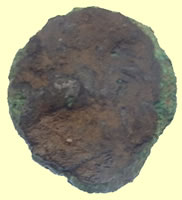 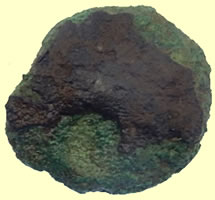 |
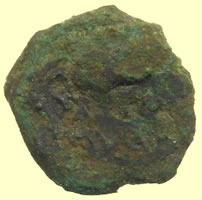 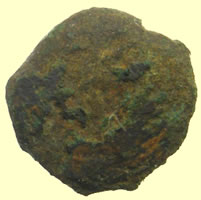 |
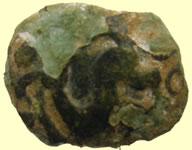 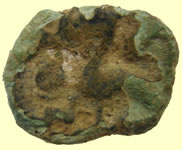 |
  |
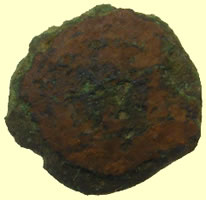 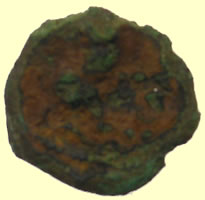 |
  |
  |
  |
  |
  |
 |
| 1st Cunobelin bronze unit | 1stC Cunbelin bronze unit Celtic Coin Index as 04.264 |
  |
  |
|
|
 |
|
